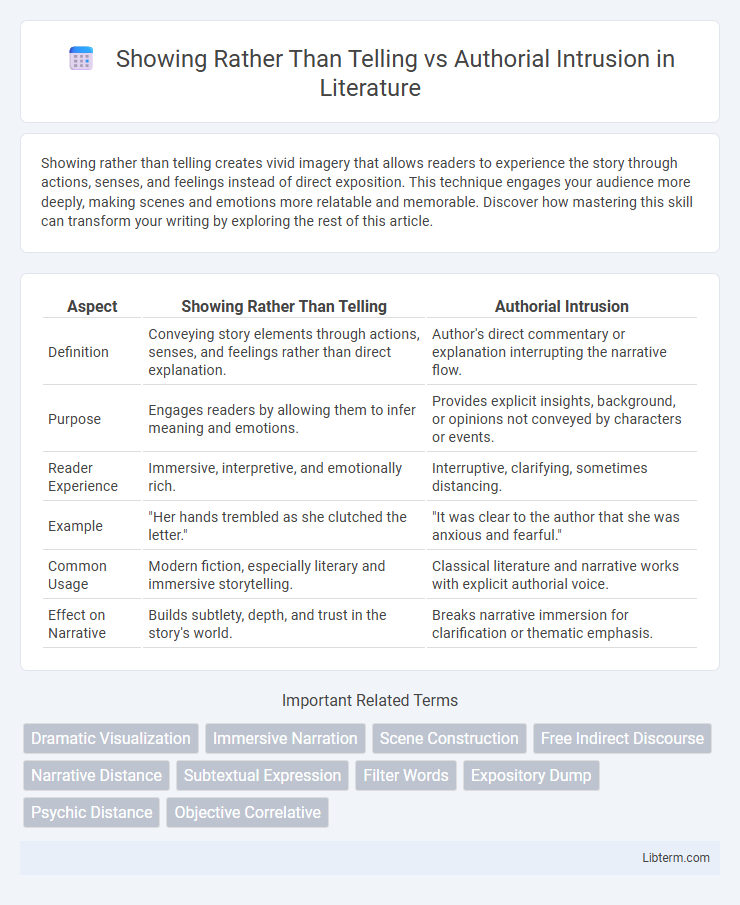Showing rather than telling creates vivid imagery that allows readers to experience the story through actions, senses, and feelings instead of direct exposition. This technique engages your audience more deeply, making scenes and emotions more relatable and memorable. Discover how mastering this skill can transform your writing by exploring the rest of this article.
Table of Comparison
| Aspect | Showing Rather Than Telling | Authorial Intrusion |
|---|---|---|
| Definition | Conveying story elements through actions, senses, and feelings rather than direct explanation. | Author's direct commentary or explanation interrupting the narrative flow. |
| Purpose | Engages readers by allowing them to infer meaning and emotions. | Provides explicit insights, background, or opinions not conveyed by characters or events. |
| Reader Experience | Immersive, interpretive, and emotionally rich. | Interruptive, clarifying, sometimes distancing. |
| Example | "Her hands trembled as she clutched the letter." | "It was clear to the author that she was anxious and fearful." |
| Common Usage | Modern fiction, especially literary and immersive storytelling. | Classical literature and narrative works with explicit authorial voice. |
| Effect on Narrative | Builds subtlety, depth, and trust in the story's world. | Breaks narrative immersion for clarification or thematic emphasis. |
Understanding "Show, Don't Tell" in Writing
Mastering "show, don't tell" in writing involves vividly depicting scenes and emotions through sensory details and character actions, allowing readers to experience the story firsthand. This technique contrasts with authorial intrusion, where the narrator directly explains or interprets events, often disrupting immersion. Employing showing enhances narrative engagement by creating a more immersive and emotionally resonant reading experience.
Defining Authorial Intrusion
Authorial intrusion occurs when the author's voice breaks into the narrative, directly addressing the reader or commenting on the story, disrupting immersion. Unlike showing rather than telling, which conveys emotions and events through character actions and sensory details, authorial intrusion explicitly informs or guides interpretation. This technique can provide insight or commentary but risks pulling readers out of the fictional world.
Key Differences Between Showing and Telling
Showing rather than telling immerses readers by using vivid imagery, sensory details, and actions to convey emotions and settings, allowing them to experience the story firsthand. Authorial intrusion occurs when the narrator directly addresses the reader or explains events and characters' feelings, breaking the immersive flow. The key difference lies in showing enabling subtle, experiential engagement through descriptive narrative while telling summarizes or interprets, often reducing emotional impact and narrative depth.
The Impact of Showing on Reader Engagement
Showing rather than telling in narrative writing immerses readers by allowing them to experience scenes through vivid sensory details, actions, and emotions, enhancing emotional connection and empathy with characters. This technique minimizes authorial intrusion, which can disrupt narrative flow and reduce reader immersion by overtly commenting on the story. The impact of showing significantly increases reader engagement by fostering an active imagination, making the story more memorable and emotionally impactful.
When Authorial Intrusion Enhances the Narrative
Authorial intrusion enhances the narrative when used strategically to provide critical context, clarify complex themes, or deepen the reader's understanding of characters' motivations beyond what showing alone can convey. This technique allows authors to guide interpretation, create ironic distance, or highlight underlying motifs that might remain obscure through purely immersive storytelling. Effective intrusions balance the immersive qualities of showing with direct commentary, enriching the narrative without disrupting reader engagement.
Common Pitfalls: Over-Telling Through Intrusion
Over-telling through authorial intrusion disrupts narrative immersion by directly explaining characters' emotions or plot points instead of letting readers infer them through actions and dialogue. This pitfall weakens storytelling by reducing subtlety and diminishing reader engagement, as the narrative voice overrides the characters' experiences. Writers should balance necessary exposition with vivid, show-don't-tell techniques to avoid overwhelming the text with intrusive commentary.
Balancing Narrative Voice and Character Experience
Balancing narrative voice and character experience requires skillfully showing rather than telling to immerse readers in the story and reveal emotions through actions and dialogue. Authorial intrusion, when the narrator directly comments or explains, can disrupt this balance by distancing readers from the character's inner world. Effective storytelling maintains subtle narrative presence that enhances character depth without overshadowing the immersive experience.
Techniques for Mastering "Show, Don't Tell
Mastering "show, don't tell" involves utilizing vivid sensory details, dynamic dialogue, and character actions to immerse readers emotionally and visually. Employing precise imagery and subtext allows writers to convey complex emotions and themes without overt explanation, reducing authorial intrusion. Balancing narrative voice with subtle cues creates a seamless storytelling experience that empowers readers to infer meaning and engage deeply with the text.
Famous Examples of Authorial Intrusion in Literature
Famous examples of authorial intrusion in literature include Laurence Sterne's "Tristram Shandy," where the narrator interrupts the narrative with direct commentary, and Jane Austen's "Northanger Abbey," which features overt authorial asides commenting on Gothic novel tropes. These intrusions contrast the "showing rather than telling" technique by explicitly addressing the reader and guiding interpretation instead of allowing the story to unfold through actions and dialogue. Such interventions create a metafictional layer that can enhance humor, critique, or thematic emphasis but risk distancing readers from immersive storytelling.
Choosing the Right Approach for Your Story
Choosing the right narrative technique hinges on balancing showing rather than telling with authorial intrusion to enhance reader engagement and convey story depth effectively. Showing immerses readers by illustrating scenes and emotions through actions and dialogue, while selective authorial intrusion offers clarity or thematic insight without disrupting narrative flow. Writers benefit from tailoring the approach to the story's tone and pacing, ensuring immersive storytelling that maintains control and resonance.
Showing Rather Than Telling Infographic

 libterm.com
libterm.com